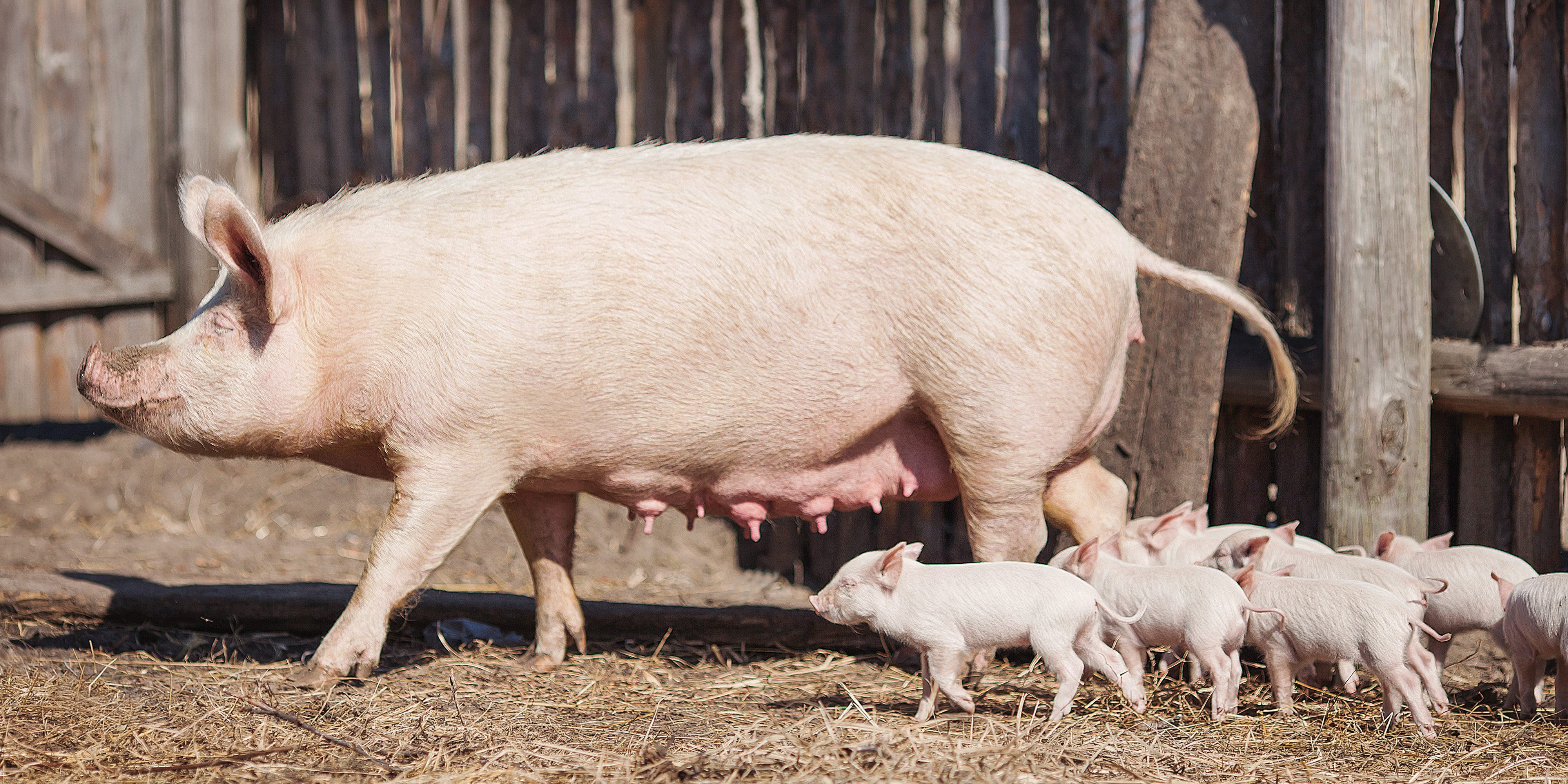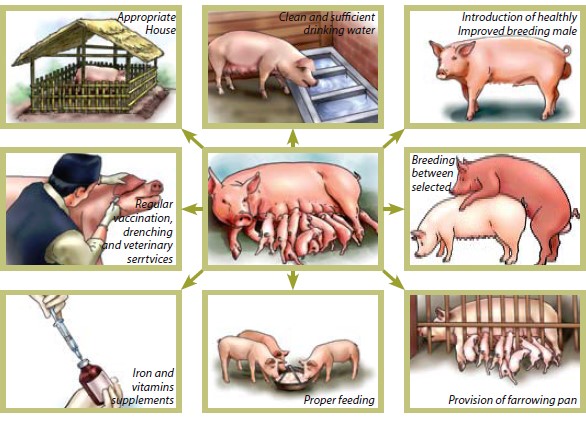



How to Farm Pigs - Health Issues
This guide from the FAO provides information on all the major diseases and parasites that may affect the pigs in your small scale or backyard pig unit. Information given on the illness includes signs and prevention.Part of Series:
< Previous Article in Series Next Article in Series >
Editor’s note: The content on this page was written specifically for farmers in Nepal. While much of the information will be applicable elsewhere, please be aware that every country has its own rules regarding caring for sick animals. You must ensure your practices are in line with official regulations in your own region.
Disease and Parasite
Sick pigs generally have the following signs:
- It may not eat or not show interest in feed /water
- It may breathe rapidly indication of a fever
- In white skin-colored pigs the skin may become reddish.
- It may have diarrhea which may sometimes be bloody or blood stained.
- Droopy ears or ears pointing downwards.
- Dull eyes.
- Dull skin and hair.
- Its tail will become limp.
- Separates it self from the rest
Parasitic diseases
Parasites are divided into external and internal parasites.
Internal parasites (Worms)
Worms are one of the most serious threats to pig keeping. There are more than 30 types affecting the intestines of pigs. The most important two are the intestinal roundworm and the tape worm.
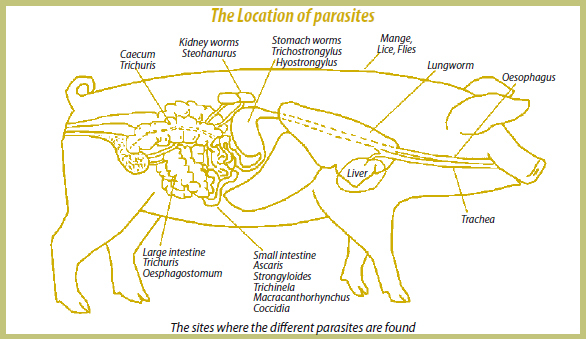
Roundworm
Roundworms live in the gut and take food from the pig. The pig can therefore become thin. Giant intestinal roundworms (Ascaris lumbricoides) are common around the world, especially in warm, moist climates. These worms are large, about the size of a pencil. The infection begins with the ingestion of eggs which are usually present in contaminated soil, or on fruits and vegetables grown in infected soil.

Symptoms
- Anorexia in advanced stages.
- Anaemia loss of condition.
- Weight loss in later stages.
- When the worms die suddenly after treatment, they can block the gut and cause sudden death
Prevention
- Control with medicine in the food is useful and provide clean and dry pens.
- Rotational grazing and periodic disinfection of pastures.
- Separation of young ones from adults.
- Washing sows before farrowing.
- Periodic deworming
- Herbal treatment: herbs such as moringa are considered to be antihelmintic (able to kill intestinal worms)
Tapeworm
Tapeworms are flat and long ribbon like creatures which are common in all parts of the world. Tapeworms do not have a digestive system so they receive their food through their skin as they absorb our nutrients. They especially absorb folic acid and vitamin B-12. These parasites may cause what is referred to as “verminous intoxication” as they put out and leave dangerous waste products in our bodies. These tapeworms can roll themselves into a ball and can be felt on the right side of the abdomen under the liver.
Pork measles is caused by tapeworms which live in the muscles of pigs. They do not usually affect the pig, but can lead to pain and the pig may find it difficult to move around. When people eat undercooked measly pork, the worms develop inside the people, and can make them very sick.

Symptoms
- Anorexia in advanced stages.
- Anaemia loss of condition.
- Weight loss in later stages.
- When the worms die suddenly after treatment, they can block the gut and cause sudden death
Prevention
- Control with medicine in the food is useful and provide clean and dry pens.
- Rotational grazing and periodic disinfection of pastures.
- Separation of young ones from adults.
- Washing sows before farrowing.
- Periodic deworming
- Herbal treatment: herbs such as moringa are considered to be antihelmintic (able to kill intestinal worms)
External parasites
External parasites mainly include mange, lies and myiasis.
Mange
It is caused by small parasites called mites that live in the skin. They provoke severe itching and irritation. Nowadays sarcoptic mange in pigs has been reported in all major swine producing countries and is prevalent in Brazilian swine herds. Lesions, or scabs, on the animals may start on any part of the body, but usually appear first on the head, around the eyes, nose, or ears; lesions may progress to hyperkeratosis and exfoliation of epidermal debris.

Symptoms
- The pig becomes itchy, and scratches and rubs against the walls of the sty and other objects with the skin between the legs, around the eyes, ears and neck being principally affected.
- The coat looks dull, and there are bare patches, heavy crusts, and lines on the body that look like ribs
- Restlessness and itching which can be very severe
- Red pimples on skin, which turn into crusts and scabs. Later the skin looks very rough, is thickened and covered with flakes scratching. Skin may show red spots or bite wounds
- Thick skin and rough hair coat
- Anaemia in severe cases especially in piglets
- Death in severe cases
Prevention
- Wash the sow before farrowing at least twice at a one week interval.
- Boars should be washed at least four times a year.
- Treat gilts upon entering the farm and before serving.
- Wash all pigs at the beginning of fattening if mange is already a problem.
- Maintain proper animal nutrition and health program to reduce severity and spread of mange. Recommended control products are: ivermectin (1% injectable), or malathion (1% spray).
- General cleanliness.
Treatment
- Remove scales and dirt with soap and water and a stiff brush.
- Afterwards the pig should be washed with organophosphate compounds. Repeat this treatment several times
- Ivermectin injection is a very effective treatment against mange and all other parasites. Spraying the animals with cattle dip also kills many parasites on the skin
- Herbal treatment: Smearing with coconut oil can be an effective control in cases of light contamination
Lice
These are blood suckers that also cause irritation of the skin. The hog louse is the largest louse species (6,4mm) commonly associated with domestic animals. It is found most frequently in the folds of skin behind the ears and between the legs. The blood-sucking activity of hog lice results in much irritation and discomfort to swine

Symptoms
- Itching
- Skin may show red spots or bite wounds.
- Thick skin and rough hair coat.
- Anaemia in severe cases especially in piglets.
Prevention
- General cleanliness
- Treat piglets before putting them in fattening house. Fatteners don't need to be treated
- Treat gilts before first service
- Treat boars twice a year
- Treat new stock on arrival and seven days later. Piglets below three weeks should not be treated
Treatment
- The insecticide benzene hexachloride is a very effective remedy (0.1 - 0.25% solution) against lice. Treatment should be repeated after 7 days since the insecticide only kills adults and not eggs.
- Lice can be kept away to a certain extent by planting a pole sturdily in the ground at an angle of 45° with an old sack wound around it immersed in crude oil or used motor-oil.
Myiasis
Disease caused by flies, which lay eggs in the wounds. The eggs hatch into larvae which live and feed on the flesh and developed into pupate, and fall off when they mature, creating more wounds.

Symptoms
- Infected wounds look very wet and dirty and the edges can be covered with a grey mass which are the eggs of flies.
- Later on, larva can be seen as screw-shaped pinkish worms crawling through the wound.
- The pigs show annoyance and try to find a shabby place.
- Death may occur.
Prevention and Treatment
- Clean the wound daily with water and disinfectant then apply insecticide on wound to cover edges too.
- Best working insecticides are the long-acting ones e.g. diazinon or supona.
- Good mange control program to prevent wounds smooth walls and floors.
- Do not use sharp objects.
- Avoid overcrowding to reduce fighting.
- Tail docking, ears notching and castration should be handled properly and the umbilical cord disinfected.
Deworming
Those dewormers that are currently approved for use are effective and usually safe when given according to label directions. These include ivermectin (Ivomec®), fenbendazole (Safe-Guard®), levamisole (Tramisol®, Levasole®), pyrantel (Banminth®), dichlorvos (Atgard®) and piperazine. Their activity varies somewhat, so refer to Table 1 for the appropriate use.
The deworming schedule should include prebreeding for all breeding stock and prefarrowing for gilts and sows, prevention of Strongyloides and roundworms in baby pigs, and one or more dewormings in weanling and growing pigs. Specific strategic schedules should be arranged with your veterinarian.
- Boars - every 6 months
- Sows - 2 weeks before farrowing and after weaning
- Piglets - 1 week after weaning
- Fatteners - 1 week after weaning and 3months latter
- Gilts - 1 week after weaning, 3 months and at 7months of age at least 2 weeks before service
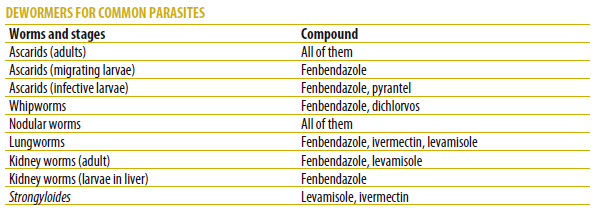
Control of Lice, Flies, Mange
- Scrub sows with Gamma BHC insecticides four days before farrowing.
- Clean and scrub the farrowing pens before use.
- Maintain proper animal nutrition and health program to reduce severity and spread. Recommended control products are: ivermectin (1% injectable), or malathion (1% spray).
Reproductive Disorders and Diseases
Anaphrodisias
When the sow does not come on heat
Symptoms
- No heat signs; This could be caused by low body weight due to poor feeding, overweight, mineral deficiency, intestinal worms, chronic disease, the animal has just given birth, heavy infestation with parasites
Prevention
- Improve feeding of mineral-rich feeds.
- Regularly deworm your animals.
- Allow the female to stay with the boar.
Treatment
- Gilts should not be treated at all because they may show anaphrodisias after every litter, if this hormone is used
- Sows should be treated on the same day as weaning, and in very severe cases, 3 weeks after weaning
- Repeating treatment is of no use
Leptospirosis
Symptoms
- Fever, anorexia, diarrhoea, bloody urine, nervous symptons caused by meningitis.
- Abortion in last trimester.
- In sows which are affected later, weak piglets are born.
- Mummified and macerated foetuses are common in the litters.
- Infertility associated with venereal spread may be responsible for repeat breeders.
Prevention and treatment
- Elimination of mite and rats and other roddents.
- Vaccination and hygienic measures. Vaccines are not available for all types of the diseases and vaccination may not prevent bloody urine.
- Treat all sows with injection or streptomycin before serving.
- Use antibiotibics especially streptomycin for all ages.
Brucellosis
Symptoms
- Anorexia, fever, stiff legs, occasional lameness, early abortion (returns to oestrus 5 - 8 weeks after service as a result of infection of service)
- Infection later in pregnancy gives rise to litter with mummified, still born or weak piglets.
- Bloody vulva discharge and endometritis.
- Retained placenta.
- Boars usually develop orchitis (inflammation of one or both testicles) and epididymitis within seven days of infection.
- The testicles are swollen and painful and permanent sterility can be the result.
Prevention and treatment
- Prevention is based on hygienic measures and purchase of stock from clean herds only.
- Never treat by antibiotics.
- No treatment/vaccination is 100% effective
- Slaughter all animals and do restocking. Restocking should be after one month.
Uterine Prolapsed

Symptoms
- The appearance of the uterus outside the vulva.
Prevention and treatment
- Uterine prolapsed reduction is often not possible since it is very traumatic and the best therapy is to amputate the whole uterus. However 50% of sows do not survive this operation, therefore slaughter should be considered.
Mastitis
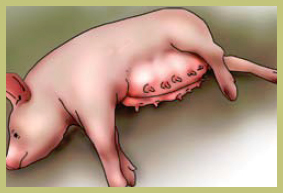
Bacterial infection causes an inflammation of the mammary organ and results in changes in milk production. These bacteria enter the wounds in the udder.
Symptoms
- Swollen, hot and painful udder.
- Absence or reduction of milk in the affected udder.
- Sow refuses to suckle her piglets. As a result, piglets squeal due to hunger.
- Sow has depression and often fever.
Prevention
- Provide adequate bedding
- Keep pig pens clean, dry and free of sharp objects, clip milk teeth of baby pigs.
Treatment
- Gently massage the affected udder with lukewarm water.
- Do not allow the young to suck milk from the infected sow.
- Remove the milk from the infected udder and discard.
- Separate sow from piglets and reduce access to teats (allow a few piglets to suckle at a time). If possible, foster piglets to lactating mothers.
- Use antibiotics. Inject penicillin-streptomycin into the muscle of hip or neck.
Endometritis (bacteria)
Symptoms
- Vulval discharge of virginal or uterine origin during urination.
- In case of metrititis, fever and agalactia may occur.
Prevention and treatment
- Antimicrobial by injection or locally by inigation of the uterus and vagina, oxytocin can be given to stimulate uteric contractions once or twice a day.
- Hygiene.
Diseases and Disorders of Digestive Tract
Scouring
- Hygienic measures should be taken to avoid or minimize scouring incidence.
- Regular deworming should also be done as a control measure to scouring
- Feed changes should be gradual and not drastic to avoid scouring
Birth diarrhoea
Symptoms
- Acute diarrhoea in piglets is watery, yellowish grey and within a very short time piglets become thin with sunken eyes due to dehydration.
- Death can occur within 2 - 3 days. Death in piglets can occur even within one day before any sign of diarrhoea is observed.
Prevention
- Keep pens, feed and watering troughs clean.
- Separate affected animals from healthy animals.
- Do not change abruptly an animal's ration.
- Make sure that piglets have sufficient colostrum within 36 hours of birth
Treatment
- Vaccination
- Plenty of drinking water with electrolytes
- Use of antibiotics.
- Herbal medicine: Fresh leaves of guava or star apple. This will treat the symptoms only.
Red diarrhoea or clostridial enteritis
Symptoms
- Acute haemorrhagic or necrotic inflammation of the gut during the first and second week of birth.
- In acute cases the diarrhea is watery with an orange-red color due to blood and its often bubbly.
- In later stages, shreds of dead tissues can be found.
- Piglets are weak and don't suckle. They get pale and die within a few days.
Prevention and treatment
- Vaccination
- Make sure that piglets have sufficient colostrums within 36 hours of birth
- Keep the pigs warm
- Cleanliness
- Contact the veterinary
Transmissible Gastroenteritis
Transmissible gastroenteritis is a common viral disease of the small intestine that causes vomiting and profuse diarrhea in pigs of all ages. It spreads rapidly. Piglets less than one-week old rarely survive the disease.
Symptoms
- Very high mortality mainly in piglets upto 14 days old.
- The piglets often vomit and have severe greenish-yellow watery diarrhoea, dehydration.
- In sows the diarrhoea is greyish, they vomit, abortion may occur.
- In fatteners the symptoms are like those in sows.
Prevention and treatment
- Give electrolytes to piglets and keep them warm.
- Antibiotics prevent secondary infection but don't provide a cure.
Fat diarrhea
Symptoms
- Faeces are pasty and fatty, white or yellowish
Prevention and treatment
- Remove creep feed for a few days.
- Use antibiotics as prescribed by a veterinary doctor.
Post diarrhea
Symptoms
- Diarrhoea with no traces of blood.
- Death from dehydration or blood poisoning (septicaemia).
Prevention and treatment
- Increase creep feed before weaning.
- Avoid stress to piglets by not mixing piglets from different litters.
- Good hygienic measures include roughage in diet.
- Use antibiotics as prescribed by a veterinary doctor.
Salmonellosis
Symptoms
- High fever, dullness, anorexia, weakness, nervous symptoms.
- Bluish-red coloring of the ears, limbs and the centre of the belly.
- Bloody spots all over the body.
- Wasting and persistent grayish diarrhea sometimes mixed with blood and shreds or necrotic material from the gut.
Prevention and treatment
- Normal hygienic measures pelleted feed, thorough cooking of the swill.
- Remove feed for two days and provide clean water.
- Use antibiotics as prescribed by a veterinary doctor.
Swine Dysentery
Known by a number of names, including bloody diarrhoea, hemorrhagic enteritis bloody scours and black scours. It affects pigs of all ages, sometimes causing death.
Symptoms
- In acute cases wasting and passing of diarrhoea containing varying amounts of mucus, blood and necrotic material.
- Fever.
- In chronic cases, pigs have greyish or brownish faeces, rough hair coat and low growth rate.
Prevention
- Delay reusing the pens of infected animals.
- Disinfect pens.
Treatment:
- Some herbal medicines (moringa tree leaves) can be used to relieve the symptoms of diarrhoea and dehydration
- Use antibiotics as prescribed by a veterinary doctor
Post weaning syndrome (oedema disease)
Symptoms
- Development of oedema and nervous signs.
- Paleness peculiar squiaky voice.
- General incoordination and loss of balance.
- Sudden death.
Prevention and treatment
- Affected piglets should be weaned by removal of sow and placed on low-level diet.
- Avoid stress.
- Hygiene.
- Include roughages in diet.
- Use antibiotics as prescribed by a veterinary doctor
Diseases of the Respiratory Tract
These include Influenza, pseudorabbies, pneumonia, atrophic rhinitis and pasteurellosis.
Influenza
Symptoms
- Affected animals are apathetic.
- Anorexia
- High fever, coughing and sneezing, difficulty in breathing
- Red eyes with discharge
- Loss of condition.
Prevention and treatment
- Good ventilation.
- Vaccination.
- No specific treatment. To prevent secondary infection, use antibiotics as prescribed by a veterinary doctor.
Pleural Pneumonia
Symptoms
- Acute cases show anorexia, high fever, laboured respiration, red or blue colouring of ear-tips, belly, legs and end of tail.
- Death within 4 - 6 hours of onset of clinical symptoms.
- Blood stained froth from mouth or nose.
- Abortion.
- In chronic cases, anorexia, coughing and depressed growth rate.
Prevention and treatment
- Vaccines only prevent mortality.
- Use antibiotics as prescribed by a veterinary doctor.
Atrophic rhinitis (inflammation of the nose)
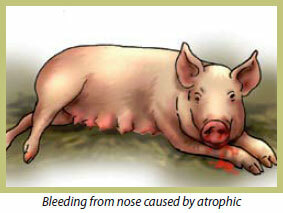
Symptoms
- Sneezing in younger pigs
- Shortening or deviation of upper jaw - poor growth
Prevention and treatment
- Hygiene
- Use antibiotics as prescribed by a veterinary doctor
Pasteurellosis
Symptoms
- Coughing
- Breathing through the mouth
Prevention and treatment
- Hygiene
- Use antibiotics as prescribed by a veterinary doctor
Porcine Respiratory and Reproductive Syndrome (PRRS)
Symptoms
- Blue ears and forced breathing
- Lactating sows have rough hair coat.
- Gilts have problem getting on heat and early abortion.
- High mortality in weaners
- In boars, high percentage of ulterated (shapeless) sperms, low sperm mortality and less libido
Prevention and treatment
- Use of antibiotics as prescribed by a veterinary doctor.
- Vaccination helps but it is so expensive that it may not be cost effective.
Disease Causing Problems in Walking

Arthritis
Symptoms
- Inflammation of joints. Thick soft joints.
Prevention and treatment
- Use antibiotics as prescribed by a veterinary doctor.
Streptococcal infections
Symptoms
- Septicaemia (blood poisoning) which may cause immediate death.
- Young pigs rarely recover
- Sudden death in older pigs.
- Fever, nervous signs and arthritis mostly in weaners and fatteners.
Prevention and treatment
- Proper hygiene. Wash sow before it enters the farrowing pen.
- Use antibiotics as prescribed by a veterinary doctor.
Greasy Pig Disease
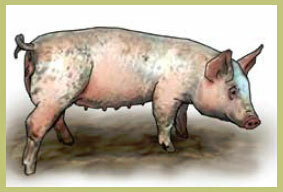
Symptoms
- Brown greasy areas of skin, scales, scabs (no itching), weight loss, death
Prevention and treatment
- Avoid fighting among pigs by mixing pigs from different pens.
- Teeth clipping, soft bedding
- Hygiene. Wash sows before entering farrowing pen.
- Use antibiotics as prescribed by a veterinary doctor.
Nutritional Disorders
Anaemia
Symptoms
- Pale skin, weak piglets with high respiratory rate.
- Jaundice
- Blood stained faeces.
- Early death
Control and treatment
- Provide iron injection or oral iron- paste containing iron
- Feeding compost- must be of good quality and supplied daily. Compost of poor quality may contain bacteria.
- Wood ash can also be put into the pen. This will not provide iron, but it does contain other important minerals.
Other Diseases

Foot and mouth disease (FMD)
Foot-and-mouth disease is an acute, highly contagious, viral of animals with hooves, such as cattle, water buffalo, goats and pigs.
Symptoms
- Sudden onset of severe lameness, fever, formation of vesicles on coronary bands.
- Blisters can be found on thin-skinned areas like udder, teats, anal area and eyelids. These blisters rapture within one day.
- There may be frothy saliva, anorexia, sometimes hooves become loose and fall off.
- Sows may abort.
Prevention and treatment
- Vaccination
- Quarantine
- Proper cooking of swill.
- Slaughter and burial.
Swine fever/Hog cholera

Symptoms
- Lesions on the body
- Fall in temperature before onset of clinical signs.
- Reddening of skin and ears.
- Incordination of hind limbs.
- Constipation diarrhoea, anorexia.
- The animal dies the next day after the attack. 95 - 100% mortality.
Prevention and treatment
- Quarantine.
- Boiling of swill.
- Restriction of movement of meat from infected areas
- Vaccination
- Disinfection
- No therapy (treatment)
Anthrax
Anthrax
Symptoms
- Oedema and swelling of the neck region.
- Dysponea (breathing difficulty).
- Fever, anorexia and passage of bloody feaces.
- Sudden death.
Prevention and treatment
- Use antibiotics (penicillin) as prescribed by a veterinary doctor.
- Thorough disinfection of the farm and burning of carcasses.
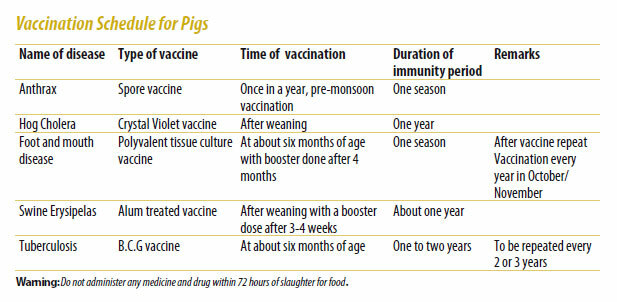
Also of Interest:
Further Reading
You can view the full FAO Farmer's Hand Book on Pig Production by clicking here.







